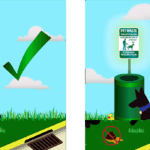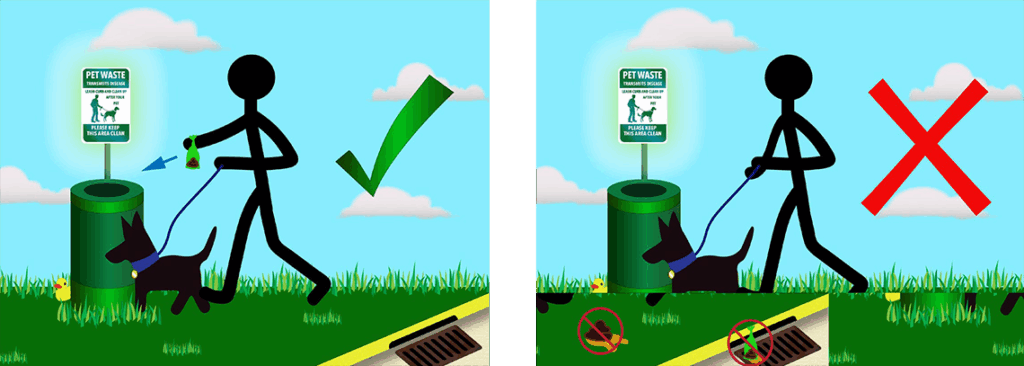
By Anne-Marie Lambert
It takes a village to clean up our waterways and rejuvenate the soil beneath our feet. I have been soaking in this topic for over a decade, studying the town’s annual reports describing efforts to eliminate pollutants leaking into our waterways and thinking through what makes a real difference.
Step one is to care enough about the communities and ecosystems that we are a part of to realize that clean waterways and healthy soil matter. In the 1970s, citizens cared enough that Congress passed the Clean Water Act. This new regard for clean water resulted in regulations that have done an impressive job of triggering cleanup actions by developers and municipalities that might not have known what to do, even if they wanted to clean their waterways.
In the 2000s, town staff and citizens like Roger Colton cared enough to draft and push through Belmont’s Stormwater Bylaw. This bylaw has become a matter-of-fact way to ensure that new developments retain stormwater on site rather than adding to our stormwater runoff problems. When the Belmont Select Board voted to support my 2014 proposal to update the standards for stormwater retention to reflect the more intense storms coming from climate change (rather than the storm data from 1961), I was very proud.
Someone else who is passionate about stormwater management recently joined Belmont’s Department of Public Works (DPW) as assistant town engineer: Wayne Chouinard. Wayne is the former town engineer in Arlington, where he worked with the University of New Hampshire to design an infiltration trench that could be installed relatively easily and cheaply next to a catch basin to filter out phosphorus and other pollutants.
Arlington worked with UNH and the Mystic River Watershed Association (MyRWA) to install 88 infiltration trenches at a rate of 15 to 25 per year. As part of Belmont’s Comprehensive Plan project, Wayne is developing an updated statement of town stormwater policy. Wayne hopes Belmont can eventually install these trenches as an add-on to regular roadwork.
In Arlington, he also worked closely with the MyRWA to educate citizens on planting rain gardens, sharing how much he knows and cares about waterways. Wayne is working on a draft statement of policy now. I am hopeful that Wayne’s knowledge and passion will result in exciting progress in Belmont.
Meanwhile, Belmont’s current outreach to citizens regarding pollution prevention meets the minimum requirements of the state’s requirement for Belmont’s Municipal Separate Storm Sewer System (MS4). It includes:
- Annual message to pet owners regarding proper management of pet waste
- Public health message about pet waste
- Educational material for owners of septic systems about proper maintenance
- Annual message in April/May regarding proper use and disposal of grass clippings
- Annual message in June/July regarding proper use of slow-release and phosphorus-free fertilizers
- Annual message in August/September/October regarding proper disposal of leaf litter
- Annual message in June regarding proper disposal of yard waste, hazardous waste, used oil, etc.
- Annual stormwater flyer (mailed with quarterly water/sewer bill in April)
During a recent interview with Wayne, he said he’d like to add a few more steps.
- Outreach to citizen groups regarding what stormwater management is and some best management practices such as “micro-swales” and “micro-basins” to retain stormwater and let it drain more slowly on your property
- Vacuuming leaves, sediment, and other particulates from driveways and walkways
- Landscaper seminar to incorporate stormwater retention features in landscape design
- Requests to owners of properties with stormwater operations and maintenance plans associated with their title to confirm appropriate stormwater control maintenance was done
I can think of more for those who are curious about how to help.
- Encourage homeowners to check out the “storm drains” and “sewer” layers on the town’s GIS map (www.mapsonline.net/belmontma/index.html) to see how far rain travels to get from your nearest stormwater grate to one of our waterways (e.g., Beaver Brook, Wellington Brook, Winn’s Brook, Little Pond, Little River, Clay Pit Pond, Blair Pond).
- Reach out to home buyers and building inspectors to ensure basement facilities and appliances connect to the same sewer main as upstairs facilities (and not out to the street, sump, or stormwater drain). Basement renovations can be the source of illegal connections to the stormwater system.
- Encourage voters to let our elected officials know that reducing the volume of pollution Belmont is sending into our waterways is a priority.
Outfalls take Belmont water away
Do you remember learning about the water cycle, about evaporation, condensation, precipitation, and collection? The natural water cycle is broken in Belmont’s two watersheds (the Charles and the Mystic rivers). A lot of the rainfall does not replenish local plants, soil, or groundwater. Instead, we have diverted it through stormwater grates and clay drain pipes until it reaches an outfall (OF) that eventually releases water into a natural water body that flows out of Belmont. This situation leaves much of the soil under our roadways and buildings dry, dead, and vulnerable to washout.
Outfalls are boundaries between our man-made infrastructure and nature. They come in all sizes and shapes. They transport road-related toxins that don’t get a chance to filter slowly through soil before entering waterways. They release sediment that doesn’t have a chance to settle out the way it would if our brooks were more meandering and less channelized. Finally, because our aging sewer pipes and stormwater drains are leaky and intermingle their flows underground, many of Belmont’s outfalls release E. coli and other sewage-related pollutants directly into waterways that eventually flow into the Charles and Mystic.
Belmont’s broken pipes
Fixing broken pipes is a job for the town and its contractors, not individual citizens. While the town staff are dedicated, and the town has spent close to $2 million from various funding sources to find and fix broken pipes over the last 10 years, Belmont’s annual reports show that progress in finding and fixing broken pipes has been slow. We are challenged to address known problems in our underground infrastructure, let alone seek problems we don’t know about yet.
The last annual MS4 report states that to date, only 35% of Belmont’s outfalls have been “completed,” meaning dry-weather investigations against EPA pollution standards are complete. However, this statistic is misleading because about 80% of Belmont land drains into just two of our 32 outfalls, OF 10 (Winn’s Brook) and OF 8 (Wellington Brook). The 11 outfalls that have been “completed” are tiny by comparison.
The scale of the potential problems with our hidden infrastructure is daunting. It’s not clear to me that the pace of repairs can keep up with the pace of new breakages in our aging infrastructure, especially given that increasingly severe weather and increasingly dense housing both cause additional strain for which our current system was not designed.
The last annual MS4 report covers progress between June 2023 and June 2024. During this period, the town’s contractor, Stantec, focused on two small outflows, OF-1 and OF-11/11A. To my eyes, the town made painfully slow progress actually finding and fixing broken pipes.
OF-1 releases stormwater from a medium-sized area that includes parts of Trapelo Road. The town had already discovered and eliminated a partial illicit connection within that area at 58 Van Ness Road in November of 2022. When Stantec sampled downstream flows in April/May 2024, they found that certain pollutants were reduced but still slightly exceeded EPA standards. They are waiting until later this year to do more measurements. In another part of the OF-1 drainage area, the town found that stormwater drains in Unity Avenue, Fairview Avenue, and Payson Road flowed even in dry weather, an indicator that sewage is likely entering the stormwater drain. By June 2024, the town inspected the drains with cameras and found some were indeed in poor or fair condition. However, because the dry-weather flows might be related to broader flooding issues, the town decided to defer any repairs until it can complete a flood study within this catchment area.
Outfall 11/11A releases stormwater into Little Pond from two small catchment areas. After taking dry- and wet-weather measurements at downstream catch basins in 2017, the town knew there was a pollution problem around Staunton Road. This period was the first year of a five-year consent decree from the EPA (see “Fix the Stormwater System: It’s the Law,” BCF Newsletter, July 2017.) It took until 2022 to find and fix a problem with a sewer line draining into a capped drain, yet measurements taken in 2023 indicated there might still be a problem.
In May 2024, the sewer lateral to one house was discovered to be broken in two places when a homeowner called the DPW about a backup. The town’s latest annual MS4 report mentions this as a problem to address with the owner in 2025. We don’t know how many more situations like this are out there and whether they will each take eight years to fix.
Besides follow-up work in the drainage areas for outfalls 1 and 11/11a this year, the town plans to focus on OF-2, which releases stormwater from a medium-sized area, including Payson Park. The town tends to pace its investments in sewer and stormwater measurements and repairs so that they coincide with road repairs driven by the state of the road surfaces. If voters do not consider addressing pollution as urgent as fixing potholes, if your staff is overloaded with other priorities, and if the EPA lets you off the hook, this makes sense.
Good news in Belmont’s new construction
The new Belmont High School included important best management practices such as permeable pavement and a hydrodynamic separator to separate sediment and floatable trash from stormwater before it drains into Clay Pit Pond. Two projects in progress include significant stormwater retrofits (skating rink and Belmont Public Library) and the town has identified five town-owned properties where impervious areas could be reduced: Chenery Middle School, the Claflin Street parking lot, Wellington School, Butler School, and the Pequossette Park/VFW Post 1271 parking lot.
I wish there were a way to increase the visibility of underground infrastructure problems. We are accumulating data slowly, but we still don’t know the full scope of the problem or even where to prioritize our efforts to find problems.
I hope that new sensor technologies and policy guidance will enable us to work together on a system-wide approach. Our “village” includes homeowners and staff engineers, pet owners and gardeners, educators, building committees, elected officials, and watershed organizations. Together, we can get this done!
Anne-Marie Lambert is a former director of the Belmont Citizens Forum.



Sorry, the comment form is closed at this time.